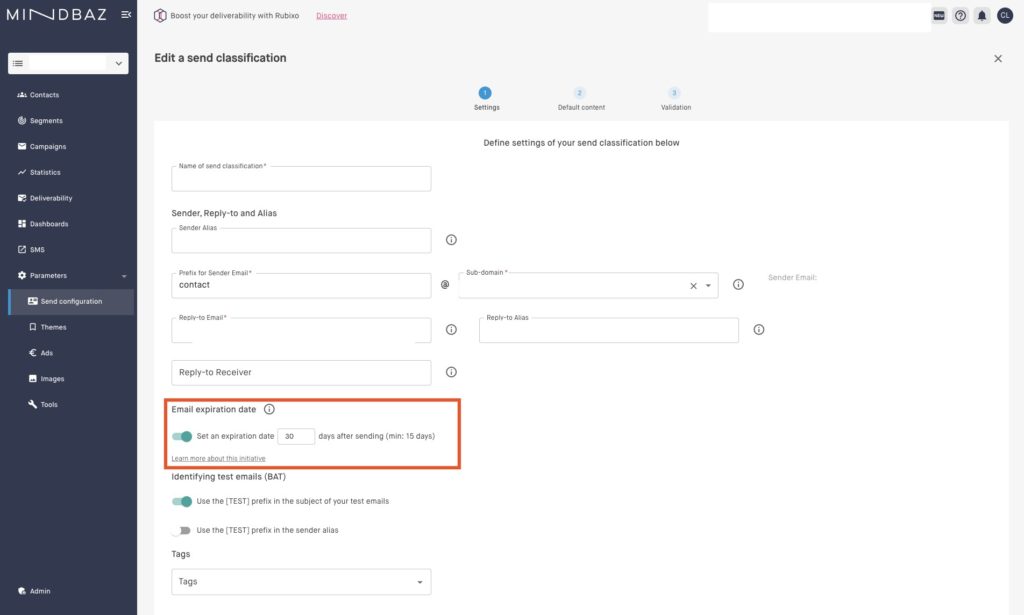Among the email sending solutions that have implemented the Expiry Date feature, six tools have taken the step. Our goal is to interview the product managers of these solutions to understand how the implementation went.
This interview aims to reassure the product teams of email sending solutions that have not yet integrated the « Expiry Date » feature into their solution. The goal is to encourage them to take action!
Interview with Pierre-Yves Dubreucq, Co-founder and CTO of two solutions Mindbaz and Sweego by Marion Duchatelet, email and CRM consultant at Badsender and co-advocacy manager of the project.

Marion Duchatelet – Badsender: Hi Pierre-Yves. Pierre-Yves, you are co-founder and CTO of two solutions: Mindbaz and Sweego. Mindbaz is an email marketing and newsletter sending solution. And Sweego is a transactional email and SMS sending platform mainly for developers and product managers.
We’re here today because in both of these tools, you’ve implemented the email expiry date feature. So the idea is to do a small series of interviews to see how you did it, how long it took you, what debates it might have generated internally. The goal is to inspire other email routing solutions to implement the expiry date in their tools. So, my first question is:
How long did the development take?
Pierre-Yves Dubreucq: Very short! For Mindbaz, it took us about ten hours: 20 hours of front and back-end development, about ten hours of design being quite generous, and then about ten hours on other lower-level aspects. But basically, it was very quick. And for Sweego, it took us just one day, because we don’t have the interface issues that we have with Mindbaz, so it was faster.
How many people were involved?
Pierre-Yves Dubreucq: For Mindbaz, five people were involved: a PM (Product Manager), someone for data, a DevOps, a back-end and a front-end developer. And for Sweego, just one person, a DevOps.
How did you prioritize this feature in your already busy product roadmap?
Pierre-Yves Dubreucq: It was our own initiative. As soon as I heard about this email expiry date project, I thought it was quite virtuous. So we were quickly excited about it. I think we were among the first to implement it. And since it’s ultimately a very short and quick project, it was fairly easy to position in the roadmap. The bulk of the work on this project is on the mailbox provider side. We « just » have to allow our clients to integrate an expiry date. So that’s easy. It aligned with our values, we didn’t need to think about it for long.
How did you think about the UX of the feature? Did it create debates internally?
Pierre-Yves Dubreucq: Within our teams, we have a fairly similar sensitivity among all our employees about everything related to ecology, so everyone was quite enthusiastic. There was no debate about « Should we do it or not. » However, there were certainly discussions about where to put the feature. Should we position it globally? Should we do it at the campaign level? There were a bit more questions about this for Mindbaz. For Sweego, everything happens through API calls or via SMTP sending, so there was no debate.
Did you implement it where your users configure the sender, subject, preheader, and sending date, or is it less visible in more technical configurations?
Pierre-Yves Dubreucq: Today, it’s at the sending configuration level. They can set a default number of days after the sending date for their emails to expire.
Have you planned the possibility to define a number of days by campaign type? For example, for my commercial emails, I set an expiry date of 30 days after sending. For my newsletters, 15 days. Or do you have to fill it in manually for each campaign?
Pierre-Yves Dubreucq: No. For now, we determine a default expiry date for all sends. But I’m not sure if we can differentiate between commercial emails, newsletter-type emails, or even transactional ones. I know one of the evolutions will be to define the expiry date directly at the campaign level, which will be easier and more precise, but for now, it’s at the sending configuration level.
Do you know the usage statistics for this feature?
Pierre-Yves Dubreucq: Today, we don’t measure the usage stats of our features at all.
Have you modified your client onboarding process so they can become aware of the feature and therefore maximize its use?
Pierre-Yves Dubreucq: The feature is presented to our clients in our onboarding documents. When we launched it, we talked about it around us. But we may not emphasize it enough. Since it doesn’t present a direct commercial interest or advantage in terms of deliverability, its adoption probably depends on our clients’ sensitivity to this type of issue.
When you talk about it, is it well received by your clients?
Pierre-Yves Dubreucq: Yes, for sure, no one is going to say otherwise. I know that when we discussed the topic from tech to tech, there were debates about the carbon footprint that the deletion would generate. It’s easy to understand that it will limit storage because we’ll have fewer emails in the inbox. However, the energy consumption related to processing the deletion of this expiry date is different. But with our marketing users, we don’t have this type of discussion. They welcome it rather well. When I present Sweego or Mindbaz, it’s one of the things I highlight.
Is it a selling point?
Pierre-Yves Dubreucq: For me, it’s something that makes me proud. To say that we’re doing something to improve things. It depends on each person’s sensibility, but it’s clearly one of the aspects I bring up when I present our solutions.
What advice would you give to a product team that wants to implement this feature?
Pierre-Yves Dubreucq: If you want to do it, go for it. It’s very quick and very easy. Honestly, I said 40 hours, but I’m almost certain it’s less.
40 hours is still a week…
Pierre-Yves Dubreucq: Yeah, but that’s taking into account all the product aspects, discussions, development, testing. For a feature, it’s not much. There aren’t 36,000 questions to ask. In terms of implementation, you just have to follow the RFC that was written. So honestly, it’s easy.
What would you say to people who refuse to prioritize this feature because they prefer to develop features considered more strategic, like AI? These other features are highly anticipated by the majority of users and could generate more revenue…
Pierre-Yves Dubreucq: Sure, AI is a breakthrough, it’s a groundswell. Today, it’s everywhere, it’s going to change our professions, it’s going to change products. Now, once again, this feature is so quick to implement that you should go for it if you want to do something good… Plus, email has a bit of a bad image in terms of ecology. Even though it’s a protocol that was invented more than 50 years ago. At a time when we didn’t have the same machine capabilities, so it’s necessarily low energy-consuming, unlike targeted advertising on social networks. Here, we have the opportunity to do a little something. It’s certain that this won’t trigger sales, but if you have clients who have an interest in ecology… it would be pretty good these days, you should go for it.
Marion Duchatelet – Badsender: Thank you, Pierre-Yves. See you soon.
Preview of the feature in Mindbaz

Commentaires récents